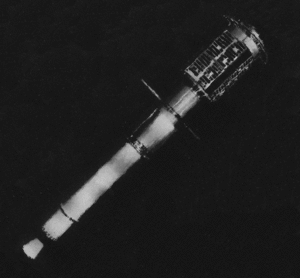 Explorer-11 satellite | |
| Names | S-15 NASA S-15 |
|---|---|
| Mission type | Gamma-ray astronomy |
| Operator | NASA |
| Harvard designation | 1961 Nu 1 |
| COSPAR ID | 1961-013A |
| SATCAT no. | 00107 |
| Website | Explorer 11 at GSFC |
| Mission duration | 6 months and 20 days |
| Spacecraft properties | |
| Spacecraft | Explorer XI |
| Spacecraft type | Science Explorer |
| Bus | S-15 |
| Manufacturer | Goddard Space Flight Center |
| Launch mass | 37.2 kg (82 lb) [1] |
| Start of mission | |
| Launch date | 27 April 1961, 14:16:38 GMT |
| Rocket | Juno II (AM-19E) |
| Launch site | Cape Canaveral, LC-26B |
| Contractor | Army Ballistic Missile Agency |
| Entered service | 27 April 1961 |
| End of mission | |
| Last contact | 17 November 1961 |
| Orbital parameters | |
| Reference system | Geocentric orbit[2] |
| Regime | Low Earth orbit |
| Perigee altitude | 486 km (302 mi) |
| Apogee altitude | 1,786 km (1,110 mi) |
| Inclination | 28.90° |
| Period | 108.10 minutes |
| Instruments | |
| Crystal Sandwich / Cherenkov Counter Phoswich-Cherenkov Counter Telescope | |
Explorer program | |
Explorer 11 (also known as S-15) was a NASA satellite that carried the first space-borne gamma-ray telescope. This marked the beginning of space gamma-ray astronomy. Launched on 27 April 1961 by a Juno II, the satellite returned data until 17 November 1961, when power supply problems ended the science mission. During the spacecraft's seven-month lifespan it detected twenty-two events from gamma-rays and approximately 22,000 events from cosmic radiation.
- ^ "Explorer 11". NASA.
- ^ "Explorer 11". NASA. 28 October 2021. Retrieved 4 November 2021.
 This article incorporates text from this source, which is in the public domain.
This article incorporates text from this source, which is in the public domain.